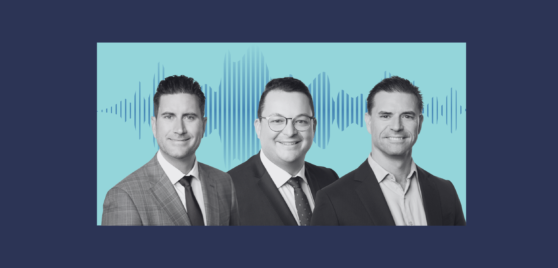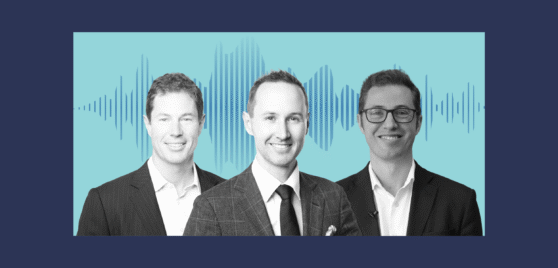Featuring Marc Whittaker.
LISTEN
READ
IML Portfolio Manager, Marc Whittaker, talks to Jason Guthrie about how IML’s small and mid cap portfolios have navigated the recent market volatility and wraps up performance for the first quarter of 2025. Marc also discusses how exposed the companies in the portfolios are to the US’s new tariff regime.
Follow our podcast, ‘Navigating the Noise’ on Spotify, Apple or Amazon to be notified of new episodes.
 |
 |
 |
Lightly edited transcript – Recorded on 26 February
Jason Guthrie: Hello and welcome to Navigating the Noise, a podcast by Natixis Investment Managers, where we bring you insights from our global collective of experts to help you make better investment decisions. I’m Jason Guthrie, and today I’m joined by Marc Whittaker from IML.
Welcome, Marc. It’s great to have you back on the podcast today.
Marc Whittaker: Thanks for having me again Jason. Clearly, interesting times that we’re seeing at the moment. So a very apt time to have a conversation.
Jason: Certainly. I look forward to getting into it. Maybe before we do get there, we obviously had some big news from your team recently with Simon Conn announcing he’d be retiring from IML in June this year. Now, I know Simon has been a founding member and circa 25 years with the firm, and you have both worked closely for nearly ten years. But I know with change does come opportunity. So congrats on taking the leadership role within the small-cap team there. You will now lead the Future Leaders and small-cap portfolios at the firm in partnership with Lucas Goode. Maybe before we do get into markets, we want to focus on that. It would be really interesting to get your thoughts on some of the main lessons that you’ve learned from Simon over the years, and maybe what investors should expect from the team going forward.
Marc : Yeah, thanks for that, Jason. It’s an opportunity that Lucas and I are very much looking forward to. It’s been wonderful working with Simon for so long, and as you say, one of the, if not the most pre-eminent investor in small caps in this market, certainly for a long period of time. I guess I’ve been fortunate to work with a number of really leading investors in the market over my own sort of 26 years. So, I’m no spring chicken either, mind you. But working with Simon has just been wonderful.
So I think the key message for investors and unit holders to take away really is that nothing will change, the processes by which we look at putting the portfolios together. The quality of the stocks that we look at, the basic understanding of what our fundamentals are, and what drives our investment decisions—when to buy, when to sell—that’s not really going to change at all. It’s really been a very consistent process over a long period of time working with Simon, and that’s our goal: to continue that.
So we’re really focused on looking at long-term valuations. And I think particularly when we’re looking at what’s happening in markets at the moment, where there’s extreme uncertainty and heightened volatility, the ability and the discipline to look at the long term I think, is key. Because when you do that, you can look through the noise. You can look through the short-term gyrations of the market.
I’m not saying that the tariff uncertainty that we’re seeing at the moment isn’t warranted, but when you’ve got a long-term view and you’re looking at underlying valuations—looking at what makes sense, what’s cheap, what’s good quality, what’s the right price to buy something at—that really holds you in good stead. So we can be more reasoned and systematic about looking at things and making buy or sell decisions. That discipline and that focus is key, and that’s not going to change.
Jason: Fantastic. Thanks, Marc. You started talking through the markets there, and it’s certainly been a wild ride in 2025. I’m keen to unpack things, particularly focusing on the first quarter, but also the last week or so since Trump’s so-called Liberation Day.
So look, we’re out of the gates early in the new year with a bang, but things have certainly changed, as there has been that uncertainty over the recent month or so. Can I get your high-level thoughts on the tariffs and how that might impact Australian companies, in particular in your small and mid-cap universe?
Marc: Well, small caps are interesting because when you think about the types of stocks that we look at in small caps—quality small caps and quality mid-caps—most of them are really domestically focused. So, they’re really hostage to the local economy or domestic economy. We don’t own a lot of resources or commodities-exposed players, which are really plays on Chinese growth. You could argue that China will be impacted by this sort of tariff regime change. But if we’re owning something like Collins Foods, for example, that sells KFC in Australia, they’re not really impacted by what’s going on in tariffs between the US and China, for example.
So we’re really focused on domestic players. A lot of what we own are necessarily importers of goods and services into the country. Again, they’re not exporting goods, they’re actually importing goods. If we see a divergence of export volumes away from the US to the rest of the world, perhaps Australia is going to be a beneficiary. We might see a flood of goods coming into what is an attractive market. Australia is an attractive market for global companies; we’re a high-income economy with a high standard of living.
So what we may well see is a flood of goods coming into the country at attractive prices, which could benefit company margins. It could benefit inflation here. We’re certainly going to see the RBA entertain rate cuts more readily, I think, given the volatility and uncertainty that we’re seeing. That, I think, arguably bodes well for the domestic outlook for domestic consumers. If you’re owning small caps that are focused on that domestic economy and on domestic consumers, I think in the longer run this could actually be quite positive for small caps. Perhaps not in the short term, but I can see that certainly playing through over the medium to longer term.
Jason: Sure, sounds like a good place to be. Maybe coming back to the quarter, Marc, how did the funds actually perform, and what were some of the main factors during the quarter to 31 March?
Marc: Yes, across the funds, by and large, performed basically ahead of or in line with where the market was at. The main news flow for the quarter was clearly reporting season. We did speak to that in a separate podcast earlier in the year, but the volatility we saw around reporting season—companies missing or beating numbers by a little bit here and there—resulted in some outsized reactions in terms of share prices as a consequence. That drove a lot of the performance for the quarter. So, where you had a little bit of disappointment, stocks tended to be sold off quite aggressively, and where you had a beat, stocks tended to be re-rated quite strongly. So not a lot of rhyme or reason really, in my view, from how stock prices moved over that quarter in some ways.
But as I say, performance was largely in line. Given where markets are at and the volatility we’ve seen, to be there or thereabouts hasn’t been that bad of a thing. Despite the fact that markets were negative for that quarter. We’re not happy about that, but looking to protect money where we can.
The interesting point that I think unit holders should take note of is that when you get this sort of unrestrained volatility and maximum uncertainty, stocks get sold off. There’s often little rhyme or reason for why they are sold off. Quality gets sold off; high-quality stocks get sold off; poor-quality stocks get sold off. Everything seems to get sold off together.
So in this sort of period, it’s really about what are the opportunities, right? Because lots of things are being sold off, and some things are deservedly so, while lots of things are undeservedly so. So that’s what we’re really focusing on now: what makes sense to put money to work in now? Does it make sense to build on existing positions or take new positions? That’s really the mindset at the moment.
Jason: Fantastic. So potentially some new names coming into the portfolio this quarter or building on existing names. I know one that you had last quarter was actually Collins Foods. Could you maybe talk to that business and the conviction behind it? I thought they were losing business; you know, the KFC component of their business to the likes of Guzman. Certainly, with my children, that’s been the case, but…keen to hear the story behind that new name.
Marc: OK. Well, Collins Foods is the leading KFC franchisee in Australia, largely in Queensland and WA. They’ve got some stores in Victoria and a handful in NSW, but they’re really exposed to Queensland and WA. If you think about the Australian economy and the parts of the country that have been performing really strongly, it’s Queensland and WA, partly on the back of resources, mind you. Given the volatility that we’re seeing in commodities, that might change a little bit, but if there’s one thing about quick service restaurants and fast food, is that it’s a very resilient category.
So if we’re worried about cost of living, we’re worried about end demand for a company’s products or services, I think quick service restaurants are a pretty good place to be. And there’s valuation support for Collins Foods as well. On our forecasts, it’s trading at around 14 times earnings next year. So for 14 times, you’re getting the leading KFC franchisee in the country. And where cost of living is a front of mind issue for lots of people – I was speaking with you about this a little bit earlier – for $26, you can feed a family of five or six. So they’ve got menu options there I’ve done some on-the-ground research, feeding the family at home myself. You can feed the family for $26-30. You mentioned Guzman and Gomez; I think you can buy one burrito for $15-$20 with the works at Guzman and Gomez.
So when you compare the value offering between something like KFC and something like Guzman and Gomez, the offering is quite compelling. The brand is very powerful; they spend a lot on marketing. You see their marketing around the football and the cricket and so forth. It’s a very strong brand, with a very strong market position, and the valuation is very compelling as well.
Jason: And it’s been performing through this more recent volatile period, from my understanding.
Marc: Yes, it has held up really well. It was one of our better performers over that last quarter as well and should hold up well in this uncertainty that we’re seeing at the moment also.
Jason: All right. Well, we’ve covered a bit there. It’s obviously been a very volatile start. Anything else to kind of wrap up on positioning into the rest of 2025?
Marc: Yeah, I think generally speaking, the portfolios are positioned as they’ve always been positioned. We’re focused on quality. We’re focused on defensive, recurring, resilient type companies. If you look at how the portfolio is currently positioned, we’re overweight healthcare. We’ve been overweight in healthcare for a while, but we like the likes of Australian Clinical Labs and IDX as good defensive companies, top lines are growing at 3% to 6%. Earnings have been a little up and down given just costs and margins, but those types of issues will normalise over time.
Given what we’re seeing at the moment in the markets, to be overweight in defensive categories, consumer staples like Ridley, Collins Food, and Select Harvest, which is an almond grower, which will ironically benefit from tariffs because they export a lot of almonds to China. The US is also the world’s largest almond exporter to China, and China clearly is buying from everyone but the US at the moment and Australia is the second largest grower and supplier of almonds globally.
So there are names in the portfolio that actually benefit from the chaos that we’re seeing at the moment. So I think the portfolios are really well positioned from a defensive point of view, from a resilience point of view. The thing with quality is that even if it does sell off in these sorts of markets, it does bounce back. When markets recover, when we move through this uncertainty and we understand where the new baseline is. Quality will recover, and that’s what we’re expecting with our portfolios as well.
Jason: Well, thank you, Marc, and thanks for joining for another quarterly update. Always great to get your perspective, particularly during this more challenging time for our investors. To our listeners, we will have the IML small and mid-cap team travelling across the major capitals next month, so please reach out if you would like to meet.
Thank you to everyone who tuned in today. If you enjoyed the episode, please click follow on your favourite podcast platform and tune in again very soon to hear more from our global collective of experts.
This podcast has been prepared and distributed by Natixis Investment Managers Australia Proprietary Limited, ABN 60 088 786 289, AFSL 246830 and includes information provided by third parties, including Investors Mutual Limited (“IML”) AFSL 229988, the responsible entity and investment manager for the IML Funds.
Although Natixis Investment Managers Australia believes that the material in this podcast is correct, no warranty of accuracy, reliability, or completeness is given, including for information provided by third parties except for liability under statute which cannot be excluded. This material is not personal advice. The material is for general information only and does not take into account your personal objectives, financial situation or needs. You should consider and consult with your professional advisor whether the information is suitable for your circumstances. The opinions expressed in the materials are those are the speakers and may not necessarily be those of Natixis Investment Managers Australia or its affiliate investment managers. Before deciding to acquire or continue to hold an investment in a fund, you should consider the information contained in the product disclosure statement in conjunction with the target market determination, TMD, available at www.stg-imlimited-staging.kinsta.cloud.
Past investment performance is not a reliable indicator of future investment performance and no guarantee of performance, return of capital, or a particular rate of return is provided. Any mention of specific company names, securities or asset classes is strictly for informational purposes only and should not be taken as a recommendation to buy, hold, or sell. Any commentary about specific securities is within the context of the investment strategy for the given portfolio. The material may not be reproduced, distributed, or published in whole or in part without the prior written consent of Natixis Investment Managers Australia.
Copyright 2025 Natixis investment Managers Australia. All rights reserved.
INVESTMENT INSIGHTS & PERFORMANCE UPDATES
Subscribe to receive IML’s regular performance updates, invitations to webinars as well as regular insights from IML’s investment team, featured in the Natixis Investment Managers Expert Collective newsletter.
IML marketing in Australia is distributed by Natixis Investment Managers, a related entity. Your subscriber details are being collected by Natixis Investment Managers Australia, on behalf of IML. Please refer to our Privacy Policy. Natixis Investment Managers Australia Pty Limited (ABN 60 088 786 289) (AFSL No. 246830) is authorised to provide financial services to wholesale clients and to provide only general financial product advice to retail clients.






